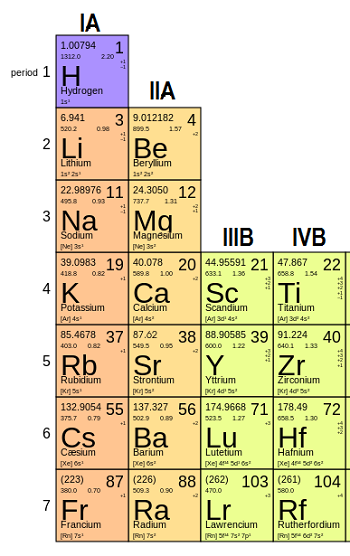General Introduction of Group I and Group II Elements
In the periodic table, elements are classified based on their properties. In this article, the general introduction to the elements of group I and group II is provided.
Group I Elements; The Alkali Metals
The elements included in the group I of the periodic table are Lithium, Sodium, Potassium, Rubidium, and Cesium. Their general electronic configuration is ns1. Their tendency to donate the valance electron is strong and they make the strong ionic bonds. In their respective periods, they have the least nuclear charge. The atomic radius increases by moving down the group so the decreasing trend is observed for the nuclear charge. In this group Cesium is the most metallic element.
These elements are marked best due to their reactivity. Physically, alkali metals are shiny and soft solids having low melting points. Alkali metals conduct electricity very well. These metals are much reactive and in nature, they can never be found in the elemental form. Even they will react with the smallest amount of oxygen and water, so they do not have any structural use. The elements in this group are dangerous as due to their reactions the produced heat may cause the flame and explosive byproducts can be produced such as hydrogen gas. So, alkali metals should never be cast into the acids or water. Almost all the salts of the alkali metals have high solubility in water. Proving their ionic nature, they form the conducting solutions. When alkali metals are burned in a flame, then a unique color is produced which can be used for their identification.

Group II Elements; Alkaline Earth Metals
The elements in group II are Beryllium (Be), Magnesium (Mg), Calcium (Ca), Strontium (Sr), and Barium (Ba). Group II elements have a general configuration of ns2. They are good conductors of electricity and heat. These elements are capable to lose two electrons from their outer shell and by reacting with other elements, they form the ionic compounds. Except for the Beryllium, all other elements form the hydroxides and alkaline oxides. All of these elements have two electrons in their valance shells so, they are easily oxidized to +2 state. These elements become softer with increasing mass. In nature none of these elements is uncombined and it is a difficult task to separate them from their compounds. Except for the Beryllium other alkaline earth metals react with the halogens and with oxygen and water. Magnesium is less reactive, so, it reacts at higher temperatures. The element Radium is radioactive and is difficult to study.
Comparatively, the reactivity of group II elements is much less than the group I elements so they are being used to dilute the acids. The alkaline earth metals are physically and chemically similar to the alkali metals but the main difference is less reactivity.
Moving down to the periodic table the reactivity of alkaline earth metals is increased. This trend is concurrent with the general periodic trends. Alkaline earth metals are neighbors to the most reactive elements. Somehow, they are much similar to their neighbor elements but quite different also.